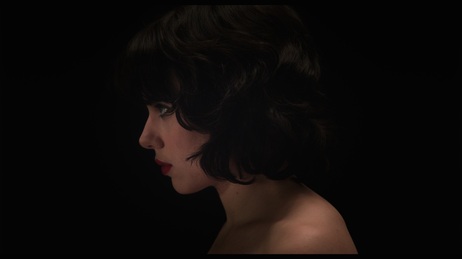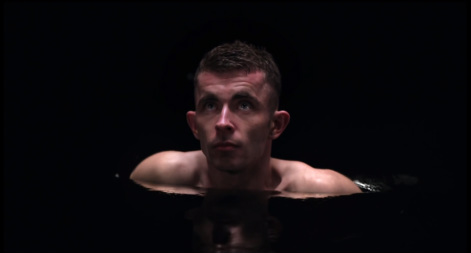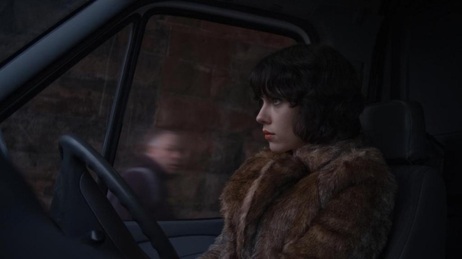|
|
Jonathan Glazer’s gothic Under the Skin strips the sci-fi genre to its barebones to rediscover something inherently abstract in the loneliness of alien stalker-wanderer Laura (Scarlett Johansson). The decade-long wait for Glazer’s visually enthralling adaptation of Michel Faber’s curious and acclaimed 2000’s novel of the same name is a welcoming hybrid of science fiction kink. Laura, the seductive extra-terrestrial, drives around Glasgow in a beaten white van, collecting men with her cherry red lips and a thick and tousled black wig. She casually enters into conversation with passers by and lures them into a non-descript, decrepit and withered house. Laura glides through the doorway, the men entranced at her heel, and coaxes them towards their mysterious demise as they are consumed and suspended in a void.
Debut composer Mica Levi’s score peaks with sharp and crisp sound effects in Glazer’s twinkling and eerie cosmos that is oddly reminiscent of a more worrisome time and space. The suspense builds with time, Glazer’s tactfully structured thriller climaxes in complete disarray, curiosity and mystery. The film’s distinctive fly-on-the-wall cinematography adds to the horror of the disturbed and distorted fantasy, just as the wallows and crackles of the harsh soundscape plunge the viewer into terrifying madness. Not once does Glazer’s creative spark dim; the film withholds as much as possible to reveal as little as needed to piece together answers to the many questions. Distanced from Glazer’s previous features Sexy Beast (2000) and Birth (2004), Under the Skin is more meditative and implicit. As Johansson freely roams Glasgow in her van, the film taints the setting with paedophilic iconography. The alien abduction storyline fittingly mimics a caricature of the dangerous child molester; Laura’s unnerving and impromptu encounters with strange men situate her alien-self as a predator. Channelling the geeky-horror aura of The X-Files (1993-2002) series, where sexual tensions entwine with unexplainable alien happenings, Under the Skin is as visually blissful as it is gothic; playfully ambiguous and equally erotic, Glazer’s film reveals an adoration for the genre, characterised by curiosity and wonder. Just as the title insinuates, the inherent mystery of Under the Skin is to do as much with interiors as exteriors. The wigged and mechanical Laura is distanced from Johansson’s recognisable mainstream image, popularised by such roles as Marvel’s sexy Russian agent Natasha Romanoff/Black Widow and as the softened voice of the Siri-esque Samantha in Spike Jonze’s Her (2013). Glazer’s adaptation interprets skin as a frailty, an identity and a canvas. Johansson’s body is an instrument as much as it is a fetish; her stardom situates the character as an oddity against a backdrop of otherwise regular scenery. The attraction of Johansson is perhaps less to do with sex appeal as much as the strangeness of seeing a Hollywood favourite so far from home. Far from the expected, her nude body is more ordinary than ornamental; her waistline is curved and has a sickly pale colour. The suits of skin left behind from her victims along with her own blemished physicality, de-eroticise, as much as demystify, Johansson’s star image and consequently embraces her potential ordinariness. Laura picks up a disfigured man (Adam Pearson) and, not thinking much of his facial disfigurement, leads him to believe she is vulnerable and sensitive. Her appearing-to-be harmless stature heightens her threatening presence, evoking the metaphorical and hysterical story of The Invasion of the Body Snatchers. Under the Skin is similarly a film of crisis, identity and survival. The hysteria is generated from distorting actuality and fantasy and Under the Skin oscillates between grounded realism and otherworldly fiction. Where it differs is in Glazer’s instilled subtly that is evocative of the horror genre, choosing to avoid the clichéd and stylised visual decor of science fiction. Under the Skin sets up moments of contrast through a human/alien dichotomy, where Laura’s cold, foreign self opposes the warmly humane presence of the Scottish passers by. Such contrast situates Laura as an irregularity and, through her differences, Laura’s character is established. She seeks to fit in but her obtruding alien customs prevents her from assimilating into the scene. She cannot even enjoy the simple pleasures of life as she chokes on a piece of cake and is perplexed by the moving pictures of a television set. Johansson’s portrayal of the lone Laura is devoted, unflinching and unrecognisable. Her thrusting movements and sluggish walk establish Johansson’s mechanical yet seductive performance. It is never quite known what Laura desires or, for that matter, where her true intentions lie as she often teeters between unearthly entity and earthly being. Glazer’s characteristic uncertainty bodes well with the film’s shadowy landscapes and Under the Skin has a similar presence of fear that quietly likens itself to the post-9/11 suffering of Steven Spielberg’s lesser remake, War of the Worlds (2005). The two films connect on a tonal level; an imbued suffering is suggested in the frequent silent pauses in Levi’s score and the sharp crackles recall the droning Tripods in Spielberg’s twenty-first century alien apocalypse. There is an erotic undertone that quivers down the spine of Glazer’s chilled and nightmarish sci-fi dystopia. It is haunted by an everlasting curiosity and visual excitement that cuts skin deep. Glazer’s otherworldly sci-fi departs from Hollywood’s space fiction faux pas to search for something more contemplating, patient and exciting. |









